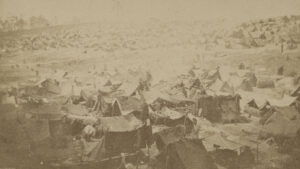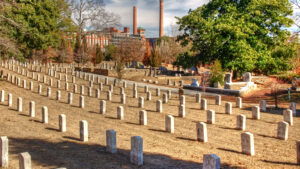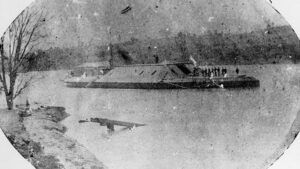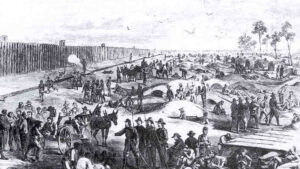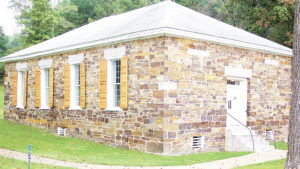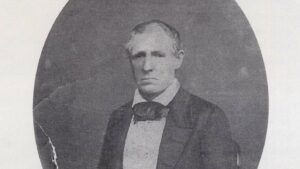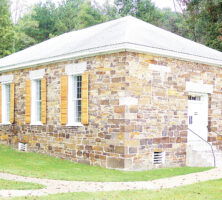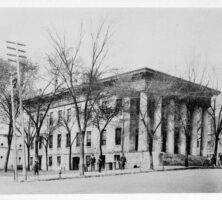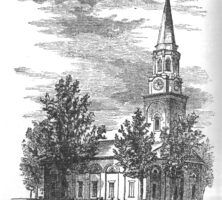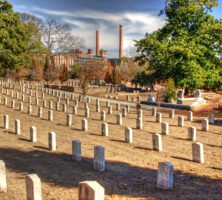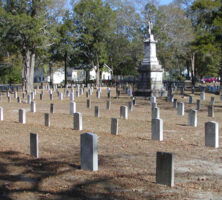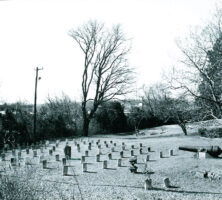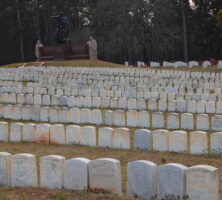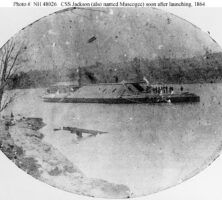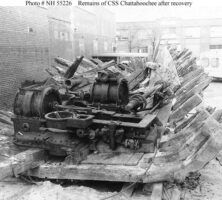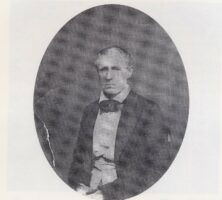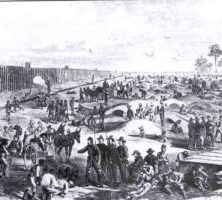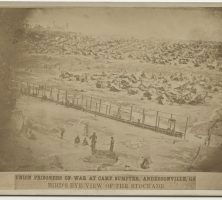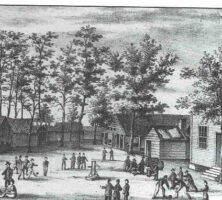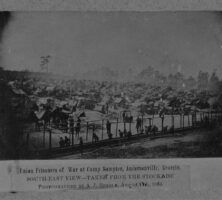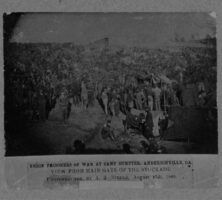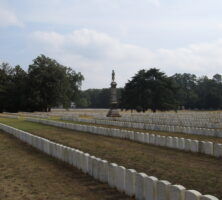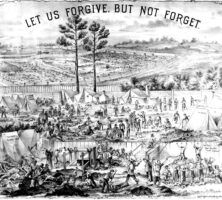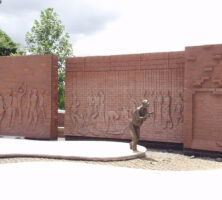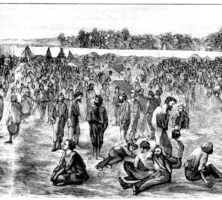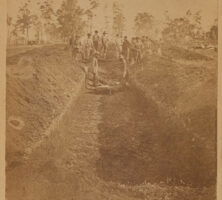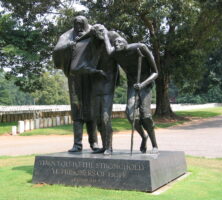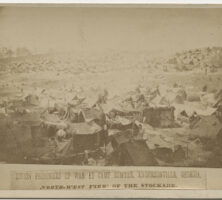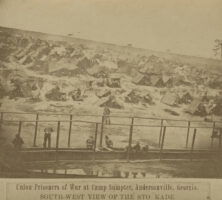The New Georgia Encyclopedia is supported by funding from A More Perfect Union, a special initiative of the National Endowment for the Humanities.
The Old Stone Church in Ringgold was built in 1849 and served as a hospital during the Civil War for troops on both sides of the conflict. The original altar and pews of the church, which today houses a Civil War museum, are still intact.
Courtesy of Catoosa County News
The New Georgia Encyclopedia does not hold the copyright for this media resource and can neither grant nor deny permission to republish or reproduce the image online or in print. All requests for permission to publish or reproduce the resource must be submitted to the rights holder.
The New Georgia Encyclopedia does not hold the copyright for this media resource and can neither grant nor deny permission to republish or reproduce the image online or in print. All requests for permission to publish or reproduce the resource must be submitted to the rights holder.
Macon City Hall, constructed in 1837, was used as a field hospital during the Civil War and served as the temporary state capitol during the final months of the war. This photograph of the building was taken in 1894.
Courtesy of Middle Georgia Archives, Washington Memorial Library.
The New Georgia Encyclopedia does not hold the copyright for this media resource and can neither grant nor deny permission to republish or reproduce the image online or in print. Requests for permission to publish or reproduce the resource may need to be submitted to the Middle Georgia Archives at Washington Memorial Library.
The New Georgia Encyclopedia does not hold the copyright for this media resource and can neither grant nor deny permission to republish or reproduce the image online or in print. All requests for permission to publish or reproduce the resource must be submitted to the rights holder.
In 1857 Joseph Ruggles Wilson, father of Woodrow Wilson, accepted the pastorate of First Presbyterian Church, located at 642 Telfair Street in Augusta. The church was used as a Confederate hospital during the Civil War.
The New Georgia Encyclopedia does not hold the copyright for this media resource and can neither grant nor deny permission to republish or reproduce the image online or in print. All requests for permission to publish or reproduce the resource must be submitted to the rights holder.
Oakland Cemetery in Atlanta is the final resting place for 6,900 Confederate soliders, including 5 generals, as well as 16 Union soldiers.
Ren and Helen Davis
The New Georgia Encyclopedia does not hold the copyright for this media resource and can neither grant nor deny permission to republish or reproduce the image online or in print. All requests for permission to publish or reproduce the resource must be submitted to the rights holder.
Around 500 Confederate soldiers and 1 Union soldier are buried at the Stonewall Confederate Cemetery in Griffin.
Photograph by Melinda Smith Mullikin, New Georgia Encyclopedia
The New Georgia Encyclopedia does not hold the copyright for this media resource and can neither grant nor deny permission to republish or reproduce the image online or in print. All requests for permission to publish or reproduce the resource must be submitted to the rights holder.
The Confederate section of Linwood Cemetery in Columbus holds around 200 Confederate soldiers killed during the Civil War.
Courtesy of Historic Linwood Foundation, Inc.
The New Georgia Encyclopedia does not hold the copyright for this media resource and can neither grant nor deny permission to republish or reproduce the image online or in print. All requests for permission to publish or reproduce the resource must be submitted to the rights holder.
The Marietta National Cemetery is located at 500 Washington Avenue in Marietta. There are more than 10,000 Union soldiers buried here, with approximately 3,000 of them unknown. Confederate soldiers were interred at a separate Confederate cemetery in Marietta.
Image from Ron Zanoni
The New Georgia Encyclopedia does not hold the copyright for this media resource and can neither grant nor deny permission to republish or reproduce the image online or in print. All requests for permission to publish or reproduce the resource must be submitted to the rights holder.
Andersonville National Cemetery in Macon County holds approximately 13,000 Union soldiers who died while imprisoned at Andersonville Prison in 1864-65. It was designated a national cemetery in 1866 and is managed today by the National Park Service.
Image from Bubba73 (talk), Jud McCranie
The New Georgia Encyclopedia does not hold the copyright for this media resource and can neither grant nor deny permission to republish or reproduce the image online or in print. All requests for permission to publish or reproduce the resource must be submitted to the rights holder.
The CSS Jackson, a Confederate ironclad built during the Civil War, is pictured in 1864 on the Chattahoochee River at Columbus.
Courtesy of U.S. Naval Historical Center
The New Georgia Encyclopedia does not hold the copyright for this media resource and can neither grant nor deny permission to republish or reproduce the image online or in print. All requests for permission to publish or reproduce the resource must be submitted to the rights holder.
The engines and lower hull of the CSS Chattahoochee, a steam-powered gunship built by the Confederate navy during the Civil War, are pictured circa 1964. In 1865 Confederate forces burned the ship on the Chattahoochee River to prevent it from falling into Union hands. The remains of the were raised from the riverbed in the mid-1960s.
Courtesy of U.S. Naval Historical Center
The New Georgia Encyclopedia does not hold the copyright for this media resource and can neither grant nor deny permission to republish or reproduce the image online or in print. All requests for permission to publish or reproduce the resource must be submitted to the rights holder.
Samuel Griswold, one of the South's leading cotton gin manufacturers, founded Griswoldville, an industrial village in Jones County. The town was located on the Central of Georgia Railway, and Union general William T. Sherman's forces destroyed it during the March to the Sea in 1864.
Courtesy of Laura Nelle O'Callaghan
The New Georgia Encyclopedia does not hold the copyright for this media resource and can neither grant nor deny permission to republish or reproduce the image online or in print. All requests for permission to publish or reproduce the resource must be submitted to the rights holder.
Union prisoners were transferred from Andersonville Prison to Camp Lawton in Millen after Sherman's attack on Atlanta in 1864. Designed to hold 40,000 inmates, the population of Camp Lawton only reached around 10,000.
The New Georgia Encyclopedia does not hold the copyright for this media resource and can neither grant nor deny permission to republish or reproduce the image online or in print. Requests for permission to publish or reproduce the resource should be submitted to the Hargrett Manuscript and Rare Book Library at the University of Georgia.
Union prisoners, seen from this bird's-eye view of the stockade, were encamped at Andersonville Prison, or Camp Sumter, in southwest Georgia. By 1864 Andersonville held the largest prison population of the Civil War, and prisoners suffered from starvation and disease as a result of severe overcrowding.
Courtesy of Hargrett Rare Book and Manuscript Library, University of Georgia Libraries, Andersonville Prison Photographs.
The New Georgia Encyclopedia does not hold the copyright for this media resource and can neither grant nor deny permission to republish or reproduce the image online or in print. Requests for permission to publish or reproduce the resource should be submitted to the Hargrett Manuscript and Rare Book Library at the University of Georgia.
Camp Oglethorpe, which opened in Macon in 1862, became most noted among Union prisoners for the number of escape tunnel operations beneath the enclosure. Although the facility was virtually abandoned in 1863 as a result of prisoner exchanges with the Union army, by 1864 more than 2,300 Union officers were imprisoned there.
Courtesy of Massachusetts Commandery Military Order of the Loyal Legion, U.S. Army Military History Institute
The New Georgia Encyclopedia does not hold the copyright for this media resource and can neither grant nor deny permission to republish or reproduce the image online or in print. All requests for permission to publish or reproduce the resource must be submitted to the rights holder.
Union prisoners of war are pictured at the Andersonville Prison in Macon County on August 17, 1864. Malnutrition and poor sanitary conditions at the camp led to the deaths of nearly 13,000 of Andersonville's 45,000 prisoners, the highest mortality rate of any Civil War prison.
Courtesy of Civil War Treasures, New-York Historical Society
The New Georgia Encyclopedia does not hold the copyright for this media resource and can neither grant nor deny permission to republish or reproduce the image online or in print. All requests for permission to publish or reproduce the resource must be submitted to the rights holder.
Union prisoners are seen crowding near the main gate of the Camp Sumter, or Andersonville, Civil War prison. The photograph was taken in August 1864 by A. J. Riddle.
Courtesy of Civil War Treasures, New-York Historical Society
The New Georgia Encyclopedia does not hold the copyright for this media resource and can neither grant nor deny permission to republish or reproduce the image online or in print. All requests for permission to publish or reproduce the resource must be submitted to the rights holder.
In 1970 Andersonville was named a National Historic Site, and includes the Confederate prison site, the cemetery, and the National Prisoner of War Museum. It is the only park in the National Park System that serves as a memorial to all American prisoners of war.
Photograph by Ken Lund
The New Georgia Encyclopedia does not hold the copyright for this media resource and can neither grant nor deny permission to republish or reproduce the image online or in print. All requests for permission to publish or reproduce the resource must be submitted to the rights holder.
An illustration of Andersonville prison bears the caption, "Let us forgive. But not forget." Andersonville had the highest mortality rate of any Civil War prison. Nearly 13,000 of the 45,000 men who entered the stockade died there, chiefly of malnutrition.
The New Georgia Encyclopedia does not hold the copyright for this media resource and can neither grant nor deny permission to republish or reproduce the image online or in print. Requests for permission to publish or reproduce the resource should be submitted to the Hargrett Manuscript and Rare Book Library at the University of Georgia.
Approximately 45,000 prisoners were held at Andersonville Prison, or Camp Sumter, the largest prison camp of the Confederacy. In 1998 the National Prisoner of War Museum opened at Andersonville.
Courtesy of Americus-Sumter Tourism Council
The New Georgia Encyclopedia does not hold the copyright for this media resource and can neither grant nor deny permission to republish or reproduce the image online or in print. All requests for permission to publish or reproduce the resource must be submitted to the rights holder.
By August 1864, Andersonville prison's population reached its greatest number, with more than 33,000 men incarcerated in the camp.
Courtesy of Georgia Historical Society.
The New Georgia Encyclopedia does not hold the copyright for this media resource and can neither grant nor deny permission to republish or reproduce the image online or in print. All requests for permission to publish or reproduce the resource must be submitted to Georgia Historical Society.
Union prisoners of war are being buried at the Civil War prison at Camp Sumter, or Andersonville.
Courtesy of Hargrett Rare Book and Manuscript Library, University of Georgia Libraries, Andersonville Prison Photographs.
The New Georgia Encyclopedia does not hold the copyright for this media resource and can neither grant nor deny permission to republish or reproduce the image online or in print. Requests for permission to publish or reproduce the resource should be submitted to the Hargrett Manuscript and Rare Book Library at the University of Georgia.
The Andersonville National Historic Site is located about twelve miles southeast of Ellaville in Schley County. A prison for Union soldiers during the Civil War, Andersonville is now maintained as a national cemetery and a major tourist attraction.
Image from Mark D L
The New Georgia Encyclopedia does not hold the copyright for this media resource and can neither grant nor deny permission to republish or reproduce the image online or in print. All requests for permission to publish or reproduce the resource must be submitted to the rights holder.
The Andersonville prison site was preserved as a national cemetery soon after it closed in 1865, largely due to efforts by Clara Barton, founder of the American Red Cross, who worked to have all the graves identified and marked.
Photograph provided by Judy Baxter
The New Georgia Encyclopedia does not hold the copyright for this media resource and can neither grant nor deny permission to republish or reproduce the image online or in print. All requests for permission to publish or reproduce the resource must be submitted to the rights holder.
View of Camp Sumter, or Andersonville, from the northwest. Union prisoners of war were held in the Civil War prison, which was established in 1864.
Courtesy of Hargrett Rare Book and Manuscript Library, University of Georgia Libraries, Andersonville Prison Photographs.
The New Georgia Encyclopedia does not hold the copyright for this media resource and can neither grant nor deny permission to republish or reproduce the image online or in print. Requests for permission to publish or reproduce the resource should be submitted to the Hargrett Manuscript and Rare Book Library at the University of Georgia.
This southwest view of the Camp Sumter, or Andersonville, stockade shows Union prisoners of war. By the summer of 1864, the Civil War prison held the largest prison population of its time.
Courtesy of Hargrett Rare Book and Manuscript Library, University of Georgia Libraries, Andersonville Prison Photographs.
The New Georgia Encyclopedia does not hold the copyright for this media resource and can neither grant nor deny permission to republish or reproduce the image online or in print. Requests for permission to publish or reproduce the resource should be submitted to the Hargrett Manuscript and Rare Book Library at the University of Georgia.
